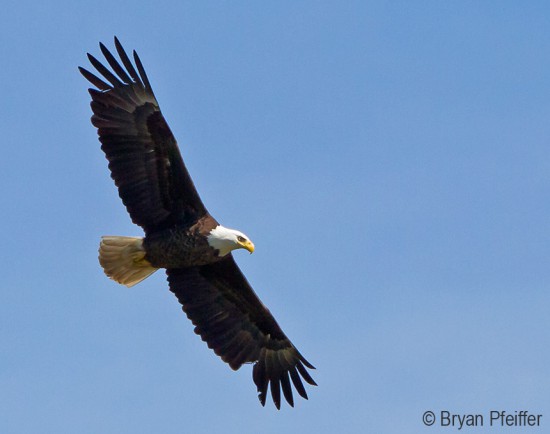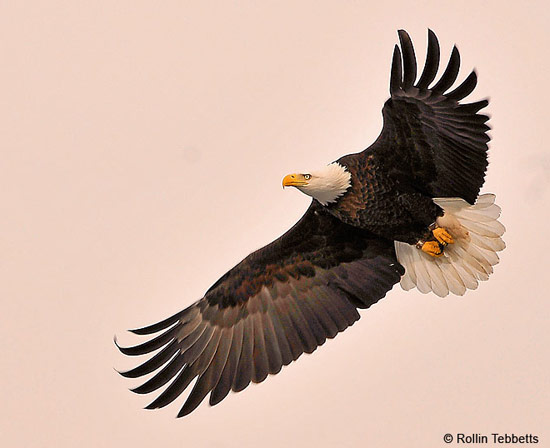Bald Eagle (and Dead Fish) Alert
 At the fertile intersection of ice and water, you will now find Bald Eagles — a lot of them. Eagles fish in open water, of course, but they also rest or feed while standing on the ice near water’s edge. Ruthless opportunists, eagles also dine on carrion and other savory dead things, including dead fish now “emerging” in the spring thaw.
At the fertile intersection of ice and water, you will now find Bald Eagles — a lot of them. Eagles fish in open water, of course, but they also rest or feed while standing on the ice near water’s edge. Ruthless opportunists, eagles also dine on carrion and other savory dead things, including dead fish now “emerging” in the spring thaw.
Such is the case developing here in Vermont on Dead Creek (and perhaps Otter Creek) in Addison County (as you’ll see on the map below). I first noticed this on Dead Creek on March 27, where a dozen or so Ring-billed Gulls and four Bald Eagles were loitering where Route 17 crosses Dead Creek (with its dead, frozen fish) in the town of Addison. Since then, other birders have seen Bald Eagles, as many as 22, at other spots along Dead Creek. These eagles are mostly migrants, although at Dead Creek on March 27 I did notice one eagle (pursued by another) carrying nesting material in the vicinity of a huge white pine. (We can only hope.)
My advice: find the dead fish on Dead Creek. You’ll probably find eagles there as well. So far, the hottest hot-spot has been the Farrell Access to Dead Creek in Addison, with more than a dozen Bald Eagles showing up there during the past few days – the purple spot on my map below. Other locations have had eagles in ones and twos or more. Once the ice goes for good on Dead Creek, check the mouth of Otter Creek near Vergennes (the northernmost point on my map), where some years ago I saw 18 Bald Eagles in a single morning.
Meanwhile, Ian Worley, professor emeritus of Environmental Studies and Plant Biology at the University of Vermont, now birding all the time, was kind enough to explain the fish mortality. Here’s Ian’s dispatch (from an email to me):
 It happens when a water body is completely iced over, and the water beneath the ice no longer has access to oxygen. In deep waters this is not as big a problem as in shallow waters, but it really amounts to how much oxygen is used by respiring animals and bacteria, including invertebrates.
It happens when a water body is completely iced over, and the water beneath the ice no longer has access to oxygen. In deep waters this is not as big a problem as in shallow waters, but it really amounts to how much oxygen is used by respiring animals and bacteria, including invertebrates.
So in quiet, shallow waters, when it ices over thickly enough to block oxygen from inflowing springs or streams, and the ice is deep enough along the shores to actually penetrate the soil or pond shore sediments, and it is not in a situation or condition for pressure cracks, the water beneath the ice is isolated from the atmosphere. Oxygen quickly becomes depleted from its use by fish, and by the decomposers of the fish poop. Clearly the case at Dead Creek this year.
This obviously is bad news for fish.
Now, this year had some of the thickest ice in a number of years, both on land and on lakes and ponds. So the lock-down of the water, sealing it off from the air, was complete and efficient. Thus the thawing of the ice was bound to be delayed well into the season of daily higher sun, and thus ever increasing insolation. Once the sun gets high enough, in shallow waters it will start heating the sediments at the bottom of the water beneath the ice.
This rising temperature does two things. The heated sediments heat the water at the bottom, which rises, and contributes to a thinning of the ice from beneath in order to collect ATVs and pickup trucks for its collection … since you can’t see the thinning of the ice from above. Secondly, it warms the invertebrates and bacteria and their oxygen demanding activities increase.
Bingo ….. fish start panicking for oxygen. If even the smallest hole appears in the ice they will mob it. Sometimes the mobbing is so intense that the fish at the hole are pushed through it onto the top of the ice, making it a fountain-of-fish dispensary for mink, raccoons, ravens, early Great Blue Herons and, of course Eald Eagels.
If many fish die beneath the ice before any holes appear, and then a spring event fractures the ice, they will float out from under the ice creating the cafeteria lines of eagles at the ice edge. (If the fish were flash frozen in the ice, you would see the eagles chipping away at the ice to get to the fish. This certainly could sometimes be the case, but normally you don’t see eagles with ice picks.)
Sometimes this process of heating the bottom sediments actually creates holes in the ice, as increased amounts of methane released bubble to the bottom of the ice dragging warmer water with them. You may have noticed that sometimes there are holes a few inches in diameter in the old ice on a pond, often with a few, thin radiating arms like an octopus. Some, many, or most of them may have a methane beginning. Once the hole is established, surface melt water from the top of the ice will find the hole as a drain, and make the radiating drain-ways to the hole.
Thus, the well oxygenated water from the top of the ice will trickle into the hole as an elixir for any remaining hypoxic or dying fish.
By the way, if you want to learn to photograph wildlife and wild places,
consider my next digital photography class on April 18
And here’s a Vermont eBird map of recent Bald Eagle sightings.

Of course, Vermont eBird is a great place to see a live map of where folks are seeing eagles and report all of your bird sightings. Check out the map at http://ebird.org/ebird/vt/map/baleag?neg=true&env.minX=-76.40287752500001&env.minY=42.55783914696901&env.maxX=-68.49272127500001&env.maxY=45.17884659654731&zh=true&gp=false&ev=Z&mr=on&bmo=4&emo=4&yr=cur
There has been an adult with a juvenile near mill river in St. Albans, all winter long. Often seen eating fish left behind by ice fishermen.
►Hoping for some dead things…◄
Well, I guess that’s one way of putting it. Lol. smh.
I am desperately hoping the weather cooperates next weekend and I am headed! Hoping for some dead things and feasting eagles!
We had an immature bald eagle at our house in Johnson yesterday. I did manage to get pictures. We have a beaver swamp at the edge of our field but it is still snow covered.